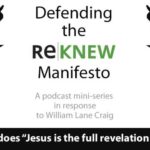We run our website the way we wished the whole internet worked: we provide high quality original content with no ads. We are funded solely by your direct support. Please consider supporting this project.

What is Progressive Revelation?
Some early church theologians argued that God had to relate to his people as spiritual infants, and over time, God’s people developed a capacity to receive clearer revelations of him. Gregory of Nazianzus, who wrote in the fourth century, claimed that God needed to allow aspects of fallen culture to get mixed in with his self-revelation; otherwise they would not have been capable of receiving it. God was acting like a wise physician who needs to blend flavorful juice with his nasty-tasting medicine.
As his people acclimated to the revelation they received, however, God was able to peel away layers of their fallen, culturally-conditioned beliefs and thereby reveal additional layers of truth about himself. This is progressive revelation.
One example of it is found in Gregory’s observation that God first “cut off the idol” from his people, but he “left the sacrifices.” Though we later learn that God doesn’t actually approve of animal sacrifices, God saw that his people at this time were too spiritually immature to abandon this barbaric practice. So, for a period of time, God graciously stooped to take on the appearance of a deity who enjoys, and even demands, the ritualistic killing of animals.
When the Israelites had grown more mature, Gregory argues, God “destroyed sacrifices,” but he “did not forbid circumcision,” though this too was also eventually removed. By taking incremental steps such as these, God grew his people to the point where at least some of them were ready to be freed completely from their past paganism. Gregory sums up the process by saying God “beguiled his people into the Gospel by gradual changes.”
This process culminated with God’s fullest and clearest revelation in Christ.
The proposal I make in Crucifixion of the Warrior God and Cross Vision is saying nothing more than this. I hold that God has always revealed his true character while stooping to accommodate the fallen and culturally conditioned state of his people as much as necessary. In his love, God was willing to allow his people to think of him along the lines of an ANE warrior deity, to the degree this was necessary, in order to progressively influence them to the point where they would be capable of receiving the truth that he is actually radically unlike these violent ANE deities. In this sense, I could agree with Gregory and say that, by making “gradual changes,” God “beguiled” his people “into the Gospel,” wherein it was revealed that God would rather be killed by enemies than to kill enemies.
—Bible, Revelation, Church Fathers
Adapted from Cross Vision, pages 72-74
Category: General
Tags: Cross Vision, Crucifixion of the Warrior God, Revelation
Related Reading

The REAL Problem with Divine Violence in the OT
As I mentioned in my previous blog, while I will continue to offer video-blogs responding to questions that come in, I’m also planning on sprinkling in reflections based on my forthcoming book, Crucifixion of the Warrior God, over the next couple months. Today, I just want to state what I consider to be the real…

Overview of Crucifixion of the Warrior God
Greg reviewed the content of his new book, Crucifixion of the Warrior God, as a part of the Woodland Hills Church Covenant Partner gathering on March 5, 2017. If you want a fairly succinct synopsis of the thesis of his book, look no further. Ten years ago, Greg set out to write a book justifying the…

The Greatest in the Kingdom (1 of 2)
This post is a summary of what was discussed at the ReKnew CrossVision Conference in regard to what and how we teach our kids about the cruciform hermeneutic. Article by Natalie Frisk Recently, while involved in an all ages musical worship experience, I watched a couple of three and four-year-olds close their eyes and experience…

Can Bible Imperfections IMPROVE the Reliability of the Bible? (podcast)
Greg talks about his new book: Inspired Imperfection: How the Bible’s Problems Enhance Its Divine Authority. Episode 537 http://traffic.libsyn.com/askgregboyd/Episode_0537.mp3

Podcast: Defending the Manifesto (4 of 10)
Greg responds to challenges by William Lane Craig from Craig’s podcast “Reasonable Faith.“ Greg discusses what it means to say that Jesus is the full revelation of God. http://traffic.libsyn.com/askgregboyd/Episode_0059.mp3

Is Hell Eternal Punishment?
The end of time, according to the Bible, is marked by hope, the hope that God’s will shall someday be done “on earth as it is in heaven.” The hope is that however terrible our present circumstances may be, before long they will all come to an end. Then creation will be what God always…
